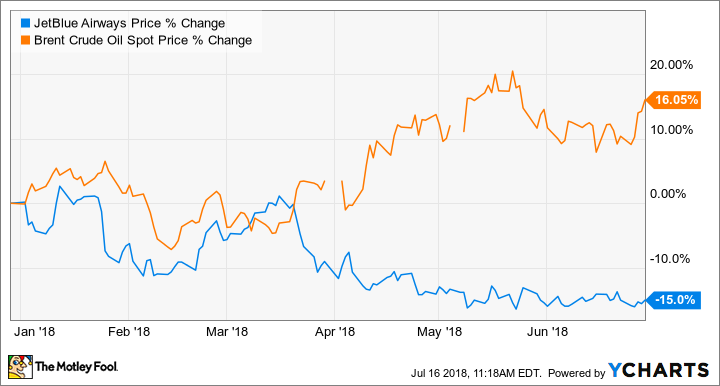What happened
Failing to fly high like the S&P 500, which climbed about 1.7%, shares of JetBlue Airways (JBLU +1.72%) faced formidable headwinds and sank about 15% through the first half of 2018, according to data from S&P Global Market Intelligence. Besides pessimism from the Street, the market responded negatively to the rise in oil prices.
So what
By several metrics, there were reasons for investors to celebrate in the first six months of the year. For one, the company reported 2017 annual revenue of $7.02 billion, representing a 5.8% increase compared to 2016. Growth was evident at the bottom of the income statement as well; the company reported a net income increase of 5.6% in 2017 compared to 2016.

Image source: Getty Images.
The Street, however, wasn't impressed and exhibited concern about the company's future prospects. In January, for example, an analyst from Bank of America Merrill Lynch downgraded JetBlue from buy to underperform and lowered his price target from $25 to $22, according to TheFly.com. Several months later, JetBlue fell victim to further criticism -- this time from an analyst at J.P. Morgan. In late April, Jamie Baker downgraded the stock from overweight to neutral, cutting his price target from $26 to $22. As reported by TheFly.com, Baker cites "a paucity in international RASM [revenue per available seat mile] exposure" and ongoing challenges in reducing nonlabor costs as factors that could impede the company's growth. Baker's bearish outlook on JetBlue was compounded by the optimism which he has for other airlines, as evidenced by his overweight ratings on American Airlines Group, Delta Air Lines, and United Continental Holdings.
Frequently, the prices of airline stocks are inversely correlated with oil prices. In other words, oil prices go up and airline stocks go down, or vice versa. This comes as no surprise since the cost of fuel is one of an airline's greatest expenses.
JetBlue, for example, reported in its most recent 10-K that aircraft fuel accounted for about 23% of its operating expenses in 2017. With the price of Brent crude creeping 16% higher through the first six months of the year, investors are clearly concerned that operating margins will be compressed and the company's profitability will suffer.
Now what
When Wall Street raises the red flag, Main Street often takes notice. Investors, however, must take analysts' opinions with a grain of salt since their time horizons are often shorter than the long-term outlooks we espouse. Likewise, a rise in oil prices may affect the bottom line in the near term, but an airline's ability to generate profits transcends one factor. Instead of taking a myopic view of the stock, investors would be better-served to dig in deeper and recognize that there are catalysts on the horizon that could help the company to soar much higher in the future.

